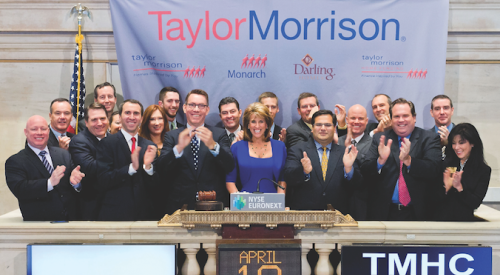|
Take a close look at this year's Top 25 rankings, (see below for complete list) then compare this list of billion-dollar brutes to last year's. You'll see that it takes more than double-digit growth just to stay in this race. (But it helps if your home track is in California or Florida!)
Houston-based David Weekley Homes, for example, dropped out of the Top 25, despite closing 660 more home sales in 2005 than the previous year, and pushing revenues up 23.4 percent to $1.27 billion. Even though Weekley operates in 16 cities in six states, the firm is heavily concentrated in the Texas markets close to its home base. And those weren't the hot markets for price appreciation during 2005. Price spikes combined with closings growth to boost the strongest movers in this race.
Fueled by fast-flipping investors, pricing surges were strongest in the Northeast, California, Arizona, Nevada and Florida. Builders with the majority of their operations in those states made the biggest moves in this year's rankings. For instance, publicly-held Toll Brothers, the Horsham, Pa.-based luxury home specialist with its base in the Northeast, but operations in all those hot states, made the biggest move of all. Toll took the inside rail from No.10 to No. 6 on the strength of a 32.3 percent increase in closings (to 8,769) and a whopping 50 percent increase in revenues (to $3.84 billion). Weekley, on the other hand, dropped from No. 25 to No. 27, a victim of stunning bursts into the Top 25 by two other private builders — Newport Beach, Calif.-based WL Homes (which pushed closings up 41.4 percent to 2,891 and revenues a staggering 67.3 percent to $1.64 billion) and Melbourne, Fla.-headquartered Mercedes Homes (which increased closings by 24.8 percent to 5,714 and revenues by 54.3 percent to $1.44 billion). WL, which markets under the name John Laing Homes, moved up from No. 26 to 20. Mercedes went from No. 30 to 23.
Private Giants Pass PublicsOne of the most surprising aspects of the race for housing revenue supremacy in 2005 was the ground lost by many small-cap public builders. WL, for instance, passed two publics (Morrison and M/I) and Mercedes one (M/I) on the way to its new position.
While the top 12 spots are still held by publicly-traded firms, seven public companies lost ground in the rankings. Reston, Va.-based NVR dropped from No.6 to 8 after being passed by both Toll and public Giant Hovnanian Enterprises of Red Bank, N.J. Atlanta's Beazer Homes also lost a spot (from No.8 in 2005 to No.9 this year). Denver's M.D.C. Holdings faded from No.9 to 10. And Weyerhaeuser Real Estate of Federal Way, Wash., retreated two positions to No.16. California-based William Lyon Homes lost two spots to No. 19, and Atlanta-based Morrison Homes dropped from No. 20 to 21. Columbus, Ohio-based M/I Homes dropped completely out of the Top 25 by sliding from No.24 to 26.
Of course, not all the public companies lost ground in the rankings. In addition to Toll's four-spot jump, Scottsdale, Ariz.-based Meritage Homes moved up a position from No.15 to 14, Technical Olympic USA, based in Hollywood, Fla., went from No.16 to 15, and Bonita Springs, Fla.-based WCI Communities moved from No. 19 to 17. The other public builders all held their positions, some with large boosts in production. For instance, Irvine, Calif.'s Standard Pacific stayed at No.12 even though it hit $4.18 billion in 2005 revenues (up from $3.48 billion in 2004), on closings of 11,694 (up from 9,091 the previous year).
Walnut, Calif.-based Shea Homes remains the top-ranked private builder, a fixture at No.13, after pushing revenues by 18 percent to $3.06 billion. But Shea is now joined in the Top 25 by WL, high-rise condo builder MCZ Development of Chicago (No. 22), Salt Lake City-based Woodside Group (No.24) and rental apartment Giant Trammell Crow (No.25), based in Atlanta, Ga.
It's obvious that the largest private builders are no longer encumbered by capital formation barriers to growth. They can hit mammoth proportions, even if it takes them a little longer to grow. And the ground lost by so many of the small-cap publics has to fuel speculation on Wall Street that the smaller public companies are ripe for acquisition by the five Supernova Giants at the very top of the rankings. Those gargantuan beasts, in fact, now face the possibility that small-cap public builders may be more accessible acquisition targets than large privates, because the private builders have no interest in selling.
Fierce Fight For No.1While there's lots of movement among builders ranked from No.6 to 25, there's none this year at the very top — in the five Supernova firms leading the race to dominate a consolidating housing industry. Bloomfield Hills, Mich.-based Pulte still leads Ft. Worth, Texas-headquartered D.R. Horton by a nose in a stretch run for the top spot in housing revenues, even though Horton has the top rung in closings. In fact, Horton became the first builder to pass 50,000 closings in a single year, hitting 51,383 in 2005. But Pulte rode a 29.5 percent increase in revenues (to $14.37 billion) to hang on to No.1 as Horton's revenues rose 26.9 percent (to $13.72 billion).
Both Pulte and Horton claim the bottom line is vastly more important to them than the top line, and they have the margins to back that up. But the intensity of their fight for No.1 in revenues seems to indicate each covets the crown. And all five Supernovas — Pulte, Horton, No.3 Lennar (based in Miami, Fla.), No.4 Centex (of Dallas, Texas) and No.5 KB Home (Los Angeles) — are now a threat to grab the lead, especially if one were to begin acquiring public builders in the next tier of the rankings, which Professional Builder dubs the Masters of the Universe.
The Big Five have clearly separated themselves from all the others in every measure of operating scale. The gap in revenues between No.5 KB Home and No.6 Toll Brothers is now nearly $3.6 billion, while KB is less than $2 billion short of No.4 Centex in housing revenues (although Centex has $3.34 billion in revenue from other sources). Toll, with less than 9,000 closings last year is not in the same race with KB (which had 37,876), despite the revenue boost the luxury builder gained from price run-ups in many markets. In fact, No.7 Hovnanian, with nearly 18,000 closings in 2005, looks to have more legs for the long run that Toll. Especially with prices now flattening in the previously overheated markets, don't be surprised if Hovnanian overtakes Toll in next year's race. The four acquisitions Hovnanian made in 2005 offer a platform for strong growth in both units and revenues in 2006.
Few analysts on Wall Street, or economists in Washington, expect the current crop of more than 20 publicly-traded builders to still be running by the end of this decade. Logic seems to dictate that some of the smaller public firms will be acquired by the larger ones. The only question is when it will happen.
UBS Investment Bank housing analyst Margaret Whelan expects a wave of consolidation in the next 12 to 18 months, but says valuations favoring the largest companies over the smaller ones will have to emerge to overcome the issues — such as "goodwill" — that discourage such deals today. "Small-cap builders with good market share positions in one or two markets would be very attractive to large builders, with national operations, who lack strong positions in those particular markets," she says. "If there's a discrepancy in the valuations of the two companies, that's what could lead to a deal."
Another factor that could lead one of the Supernovas to make a bid for a second-tier public builder would be the opportunity to add a market segment or a different business model. "Toll, NVR and WCI (the Florida.-based specialist in coastal condo towers) all have unique business models that could be very enticing to one of the Big Five," Whelan says. "I like the concept."
Pulte CEO Richard Dugas Jr. is interested, but cautious. "None of our plans assume any M&A activity, but we are not blind to the opportunity. It would take the right set of circumstances to be the catalyst for it. We are intrigued by the possibility, but there are precious few companies out there with a brand anything like what we got with our Del Webb deal."
2006: A Very Different RaceWhile price appreciation was a major element of Top 25 growth in 2005, the biggest run-ups look to be long gone this year. Late last fall, investors fled the markets where they pushed prices up most dramatically. Now those markets are languishing, with torpid sales and many builders resorting to incentives, some of them in six figures. Uncertainty is the prevailing sentiment most builders express about 2006, fear is the one they don't mention.
 |
It seems likely that it won't take double-digit growth in 2006 revenues to hold onto a position in next spring's Top 25 run for the roses. But it may take more closings to duplicate 2005's revenue totals. The big public builders say they are certain sales will pick up once they work through the temporary over-supply situations produced by investors dumping housing units. "Investors are gone, and their homes are back on the market," says Pulte's Dugas. "That's adding to supply, and a lot of people are sitting on the sidelines, trying to determine what a good buy looks like. But we've got some of the best economic conditions in recent memory in many markets.
"Look at the Eastern seaboard," he says. "There's very strong job growth. The (national) fundamentals are still good — positive population growth, strong immigration. This is more of a pause, people catching their breath. We think 2006 will be a very good year for housing. As good as the last few? No, I doubt it, because you won't see the same price appreciation. I'd say this year is going to be more of a 'normal' housing environment."
The public builders have to take that position because Wall Street demands that they continue to grow. Some private builders are not quite so confident. "If you ask me if I'm nervous about this year, I'd have to say yes," says Mercedes Homes principal and COO Scott Buescher. "The investors were both a blessing and a curse. They allowed us to push margins, but the scary thing now is that we have more of those houses turning into specs than we'd like. When you have three years like we've had, you start to believe that's the new reality. And you start buying land to feed the machine at that pace.
"Then it goes away. The best thing, we've found, is to stay up all night and worry. And that's what we're doing," Buescher laughs. But it's a nervous laugh. He's planning for a 20 percent reduction in sales and production, just in case.
| 2006 Rank | 2005 Rank | Biggest Movers in Rank | Change in Rank |
| 23 | 30 | Mercedes Homes, Inc. | 7 |
| 20 | 26 | WL Homes LLC aka John Laing Homes | 6 |
| 6 | 10 | Toll Brothers, Inc. | 4 |
| 24 | 27 | Woodside Group Inc. | 3 |
| 17 | 19 | WCI Communities, Inc | 2 |
| 14 | 15 | Meritage Homes Corporation | 1 |
| 15 | 16 | Technical Olympic USA, Inc. | 1 |
| 2006 Rank Total New | 2005 Rank | Company | City | State | Total New | |
| Residential Closings1 | Residential Revenues | |||||
| 1 | 1 | Pulte Homes, Inc. | Bloomfield Hills | MI | $14,370,667,000 | 45,630 |
| 2 | 2 | D.R. Horton, Inc. | Ft. Worth | TX | $13,716,638,000 | 51,383 |
| 3 | 3 | Lennar Corporation2 | Miami | FL | $12,711,789,000 | 42,359 |
| 4 | 4 | Centex Corporation | Dallas | TX | $11,330,467,395 | 37,876 |
| 5 | 5 | KB Home | Los Angeles | CA | $9,364,803,000 | 37,140 |
| 6 | 10 | Toll Brothers, Inc. | Horsham | PA | $5,759,301,000 | 8,769 |
| 7 | 7 | Hovnanian Enterprises, Inc. | Red Bank | NJ | $5,707,906,000 | 17,783 |
| 8 | 6 | NVR, Inc. | Reston | VA | $5,177,743,000 | 13,787 |
| 9 | 8 | Beazer Homes USA, Inc. | Atlanta | GA | $5,093,346,000 | 18,401 |
| 10 | 9 | M.D.C. Holdings, Inc. | Denver | CO | $4,802,875,000 | 15,307 |
| 11 | 11 | The Ryland Group, Inc. | Calabasas | CA | $4,628,889,000 | 16,673 |
| 12 | 12 | Standard Pacific Corp.3 | Irvine | CA | $4,178,159,576 | 11,694 |
| 13 | 13 | Shea Homes | Walnut | CA | $3,060,042,000 | 6,901 |
| 14 | 15 | Meritage Homes Corporation | Scottsdale | AZ | $2,996,945,963 | 9,406 |
| 15 | 16 | Technical Olympic USA, Inc.3 | Hollywood | FL | $2,810,700,000 | 9,435 |
| 16 | 14 | Weyerhaeuser Real Estate Company | Federal Way | WA | $2,686,430,161 | 5,647 |
| 17 | 19 | WCI Communities, Inc | Bonita Springs | FL | $2,217,400,000 | 2,909 |
| 18 | 18 | Taylor Woodrow, Inc. | Bradenton | FL | $2,078,111,000 | 3,932 |
| 19 | 17 | William Lyon Homes | Newport Beach | CA | $1,745,067,000 | 3,196 |
| 20 | 26 | WL Homes LLC aka John Laing Homes | Newport Beach | CA | $1,634,579,000 | 2,891 |
| 21 | 20 | Morrison Homes | Alpharetta | GA | $1,539,000,000 | 4,921 |
| 22 | 21 | MCZ Development | Chicago | IL | $1,450,000,000 | 4,020 |
| 23 | 30 | Mercedes Homes, Inc. | Melbourne | FL | $1,438,000,000 | 5,714 |
| 24 | 27 | Woodside Group Inc. | North Salt Lake City | UT | $1,296,718,423 | 3,676 |
| 25 | 23 | Trammell Crow Residential | Atlanta | GA | $1,291,618,000 | 9,784 |
| 1 - Completions for rental 2 - Includes units related to unconsolidated joint ventures whose revenues are not included in totals 3 - Includes revenues from unconsolidated joint ventures | ||||||
| 2006 Rank | 2005 Rank | Company | Change in rank |
| 8 | 6 | NVR, Inc. | -2 |
| 16 | 14 | Weyerhaeuser Real Estate Company | -2 |
| 19 | 17 | William Lyon Homes | -2 |
| 25 | 23 | Trammell Crow Residential | -2 |
| 9 | 8 | Beazer Homes USA, Inc. | -1 |
| 10 | 9 | M.D.C. Holdings, Inc. | -1 |
| 21 | 20 | Morrison Homes | -1 |
| 22 | 21 | MCZ Development | -1 |
|
















